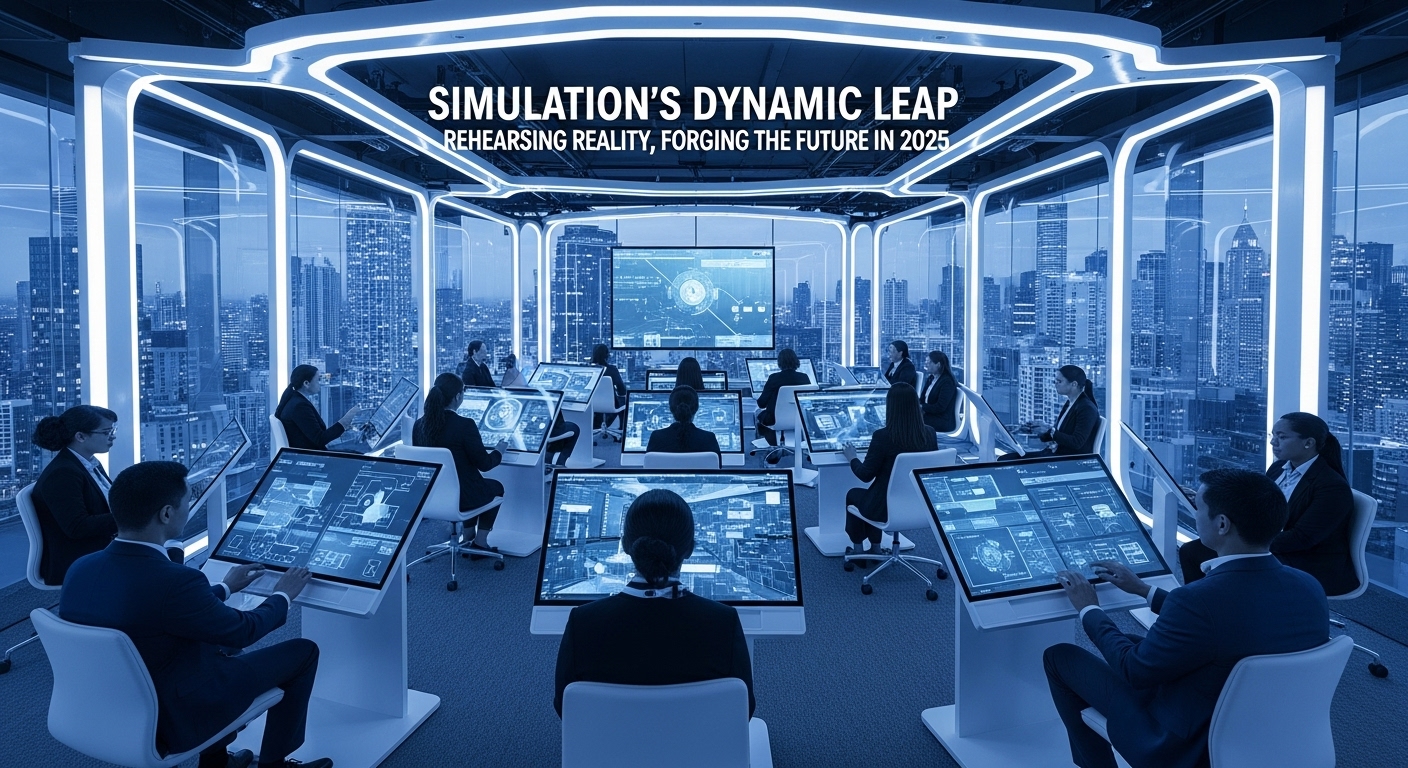In an increasingly complex and rapidly changing world, the ability to predict, test, and optimize without the costs or risks of real-world experimentation is invaluable. This is the power of “simulation” – the technique of modeling a real-world process or system over time to gain insights into its behavior. From designing safer aircraft to training surgeons, optimizing logistics, or even predicting climate patterns, simulation in 2025 is more sophisticated and pervasive than ever, fundamentally transforming how industries innovate, educate, and make critical decisions across the globe.
What Defines Modern Simulation? Bridging the Physical and Digital
At its core, simulation creates a virtual replica of a physical environment, system, or process. This digital twin allows users to:
- Test Hypotheses: Experiment with different variables and scenarios to see how a system might react under various conditions, enabling “what-if” analyses.
- Analyze Performance: Understand the efficiency, bottlenecks, and potential failure points of a design or process before committing to physical implementation, saving significant time and resources.
- Train and Develop Skills: Provide a safe, risk-free, and repeatable environment for individuals to practice complex tasks and make critical decisions, reducing the risk of errors in real-world situations.
- Optimize Operations: Fine-tune processes, resource allocation, and workflows to maximize efficiency, minimize waste, and improve overall output, from factory floors to supply chains.
Simulation transcends simple modeling; it’s about bringing models to life to observe their dynamic behavior over time, often driven by real-time data from their physical counterparts.
A Journey Through Simulation History: From War Games to Digital Twins
The concept of simulation has a long and varied history:
- Ancient & Early Forms: Ancient militaries used sand tables to plan battles. War games and strategic exercises have been used for centuries to train leaders and test tactics.
- Early Computing Era (Mid-20th Century): With the advent of computers, simulations became increasingly complex. Early applications were predominantly in military (e.g., flight simulators for pilot training) and scientific fields (e.g., weather prediction, nuclear reactions modeling).
- Manufacturing & Engineering (Late 20th Century): Computer-aided design (CAD) and computer-aided engineering (CAE) tools allowed engineers to simulate mechanical stress, fluid dynamics, and thermal performance of products before physical prototyping, revolutionizing product design cycles and reducing costs.
- Digital Twins Emerge (21st Century): The concept of the “digital twin” – a virtual replica of a physical asset, system, or process that is continuously updated with real-time sensor data – has transformed simulation. Digital twins allow for real-time diagnostics, predictive maintenance, and continuous operational optimization, offering a richer and more dynamic study environment than traditional simulations.
The Power of Simulation in Various Industries (2025 Trends)
In 2025, simulation is no longer a niche tool; it’s an indispensable component across a multitude of sectors:
- Engineering & Manufacturing:
- Product Design & Testing: Simulating mechanical stress, heat flow, and fluid dynamics ensures optimal designs before physical prototypes, drastically reducing development costs and time-to-market. Virtual crash simulations in the automotive industry ensure vehicle safety with fewer physical tests. Generative design, a form of AI combined with simulation, is creating a feedback loop where AI proposes solutions, simulation tests them, and the best ideas are refined.
- Process Optimization & Virtual Commissioning: Simulating factory layouts, supply chains, and material flow helps improve efficiency and minimize waste. Virtual commissioning allows testing and validating complex machinery and control systems in a virtual environment before physical deployment, ensuring smooth integration and faster setup times.
- Healthcare:
- Medical Training: Virtual patients and high-fidelity mannequin simulators allow healthcare professionals to practice surgeries, diagnoses, emergency responses, and patient care in a risk-free environment. Healthcare Simulation Week 2025 highlights simulation’s vital role in improving patient safety and efficiency. Surgeons are using detailed 3D digital twins of patient anatomy for pre-surgical planning.
- Drug Discovery & Clinical Trials: Simulating drug behavior in human biology, including biomolecular dynamics, helps accelerate the development of new therapies and reduces the time and cost of clinical trials.
- Hospital Operations: Optimizing patient flow, resource allocation, and emergency response protocols within hospital systems using digital twins and AI-driven simulation engines.
- Automotive & Aerospace:
- Vehicle Development: Used extensively for designing, testing, and optimizing vehicles, from autonomous driving systems (simulating billions of driving scenarios virtually is faster and safer than physical testing) to aerodynamic performance and structural integrity. Digital twins of entire aircraft fleets enable real-time monitoring of health and performance.
- Pilot/Driver Training: Flight simulators and advanced driving simulators provide highly realistic, immersive training for pilots, astronauts, and race car drivers.
- Energy & Utilities:
- Grid Management: Accurately forecasting grid load by simulating demand and supply patterns across various scenarios, optimizing load balancing and energy storage strategies. Digital twins also help assess environmental impact by simulating emissions and resource consumption.
- Education: Interactive simulation software allows students to conduct virtual experiments in physics, chemistry, and engineering, or to experience complex business management scenarios, leading to deeper understanding and higher retention. Gamified simulations enhance engagement and motivation.
- Logistics & Supply Chain: Optimizing routing, inventory management, warehouse operations, and overall supply chain resilience to minimize costs and improve delivery times. Virtual twins are crucial for simulating real-world supply chain processes, enhancing demand forecasting, and improving response speed and accuracy.
Key Trends Shaping Simulation in 2025
- AI-Powered Simulation Modeling: Artificial Intelligence is revolutionizing simulation. AI algorithms can generate dynamic and adaptive scenarios, respond intelligently to user actions, provide real-time insights, summarize results, and even enable conversational interaction with models. Machine learning models are embedded into simulations to test and refine AI-driven solutions in risk-free environments. The global simulation software market is projected to reach $27.19 billion in 2025, with a robust CAGR driven significantly by AI integration.
- Cloud-Based Simulation: The integration of all technologies (CAD, control technology, robotics) into cloud-based platforms enables flexible and efficient simulations. Teams can collaborate globally, benefiting from centralized data and powerful computing infrastructure, significantly reducing hardware costs for users.
- Real-Time Simulation: Crucial for control technology and robotics, real-time simulation allows precise testing of mechanics and control technology in interaction with material flow, significantly easing real-world commissioning and enabling predictive maintenance.
- Industrial Metaverse & Immersive Visualization: Advancements in 3D animation (e.g., AnyLogic’s integration with NVIDIA Omniverse for photorealistic visualization) and Virtual Reality (VR)/Augmented Reality (AR) allow users to step inside their models, making it easier to analyze complex systems and collaborate in immersive environments.
- Digital Twins Proliferation: The digital twin concept is maturing, with virtual replicas of physical assets, environments, or systems being widely adopted for real-time training, diagnostics, and predictive simulation, integrating with IoT data and live sensors. The global digital twin market is projected to reach $40 billion by 2025.
- Sustainability Optimization: Simulation software is increasingly supporting sustainable decisions by optimizing resource-saving processes, minimizing energy consumption, and helping develop environmentally friendly alternatives. Simulation models can assess the environmental impact of operations by simulating emissions and resource consumption.
Simulation is transforming industries by providing a cost-effective, efficient, and innovative approach to testing and optimization. From product design to energy management, its applications are vast and impactful. As technology continues to advance, integrating AI, cloud computing, and digital twin capabilities, simulation tools will become even more sophisticated, making them an absolute necessity for businesses to thrive in an era of rapid innovation and digital transformation.

